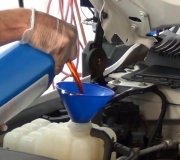Where do I connect the T?
Where does this hose go/connect from and to?
I read it's supposed to be on the heater core inlet hose.
On my Jeep the heater core is in front of the radiator and air blows through it first. The heater core has two hoses, the top heater core hose is connected to the heater core and the radiator. The bottom heater core hose is connected to the bottom somewhere near the engine but not sure. Anyhow, which hose do I use, the heater hose that connected from the heater core to the radiator or the one that is going somewhere near the engine.
Friday, June 5th, 2009 AT 10:36 PM




